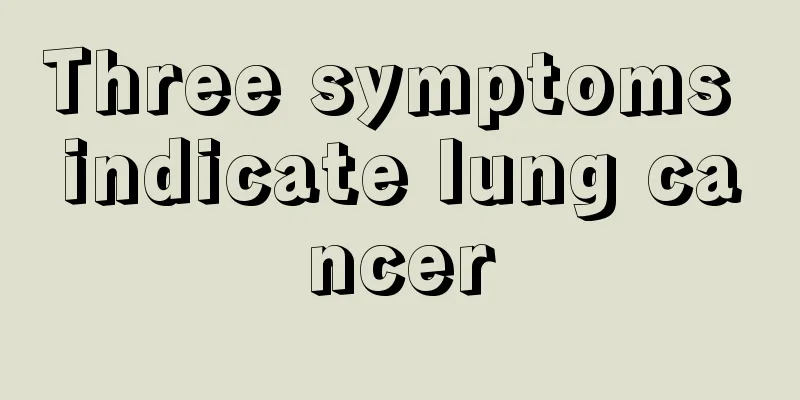Three symptoms indicate lung cancer

|
There are no three symptoms that indicate lung cancer. The definitive diagnosis of lung cancer is pathological examination. However, lung cancer patients may experience persistent cough, hemoptysis or bloody sputum, chest pain, weight loss, and dyspnea. In order to detect and treat lung cancer in a timely manner, you should pay close attention to possible symptoms and symptom changes. The details are as follows: 1. Persistent cough: Lung cancer patients often have unexplained persistent coughs that gradually worsen. If a persistent cough occurs, seek medical attention immediately and have a chest X-ray or CT scan to determine if a tumor is present. If lung cancer is diagnosed, the patient should receive chemotherapy, radiotherapy, or surgery under the guidance of a doctor. 2. Hemoptysis or bloody sputum: Lung cancer patients may cough up blood or bloody sputum, which is a manifestation of lung tumor invasion of blood vessels. If hemoptysis or bloody sputum symptoms occur, you should seek medical attention immediately and confirm the condition through bronchoscopy and sputum cytology. After the diagnosis is confirmed, appropriate treatment plans should be taken under the guidance of a doctor, such as surgical removal of the tumor or radiotherapy and chemotherapy. 3. Chest pain: Chest pain caused by lung cancer is usually persistent and has a clear location, unrelated to respiratory activity. If you experience persistent chest pain of unknown cause, you should seek medical attention as soon as possible and have a chest imaging examination to rule out lung tumors. After lung cancer is diagnosed, surgery, radiotherapy, or chemotherapy should be selected based on the specific location and stage of the tumor. 4. Weight loss: Lung cancer patients often experience significant weight loss in a short period of time without other obvious reasons. If unexplained rapid weight loss occurs, you should seek medical attention as soon as possible to determine the cause through a detailed physical examination and laboratory tests. After lung cancer is diagnosed, comprehensive treatment measures should be taken according to the specific situation, such as nutritional support therapy and anti-tumor therapy. 5. Dyspnea: Lung cancer may cause airway obstruction or damage to the lung parenchyma, which can cause dyspnea. If dyspnea occurs, seek medical attention immediately and determine the cause through pulmonary function tests and imaging tests. After lung cancer is diagnosed, appropriate treatment measures such as bronchodilator therapy and anti-tumor therapy should be taken under the guidance of a doctor. In order to detect and treat lung cancer in time, we should pay close attention to the changes in these symptoms and seek medical attention in time when abnormalities occur. Treatments for lung cancer include surgery, radiotherapy and chemotherapy. The appropriate treatment plan should be selected under the guidance of a doctor according to the specific condition. |
>>: Early symptoms of testicular cancer
Recommend
How to treat thyroid cancer? What are the common treatments for thyroid cancer?
Thyroid cancer is pathologically divided into pap...
How can I avoid leaving scars on my wounds
No matter how deep or shallow, or how big or smal...
Can boiling loquat leaves with brown sugar cure cough?
Loquat leaves are a very effective Chinese medici...
The efficacy and function of freshly squeezed orange juice
Many people think that freshly squeezed orange ju...
What to do if you eat maggots
In daily life, when we don’t want to cook, we wil...
Common nursing problems and measures
In the hospital, the people who spend the most ti...
Symptoms of bladder cancer lymph node metastasis
Symptoms of bladder cancer lymph node metastasis:...
What are the methods to remove acne pits and acne marks
The face is very important as the basis of a pers...
Can glioma be completely cured?
Patients suffering from brain glioma can be said ...
7 major groups of people are susceptible to pancreatic cancer
Pancreatic cancer is one of the common malignant ...
Efficacy and function of dried motherwort
As an important gynecological medicine, motherwor...
Nasopharyngeal cancer is so painful, how long can I live? What medicine should I take?
The severity of nasopharyngeal carcinoma pain is ...
What to do if the external auditory canal hurts and becomes inflamed
Many people's ears are prone to pain. This pa...
About life expectancy after endometrial cancer surgery
How long can patients with endometrial cancer liv...
Will jumping make your legs thicker? Correct practice will make you have a good figure
The sport of jumping includes high jump, long jum...









